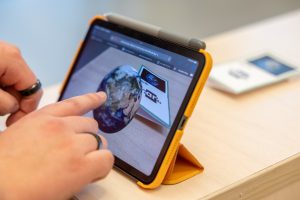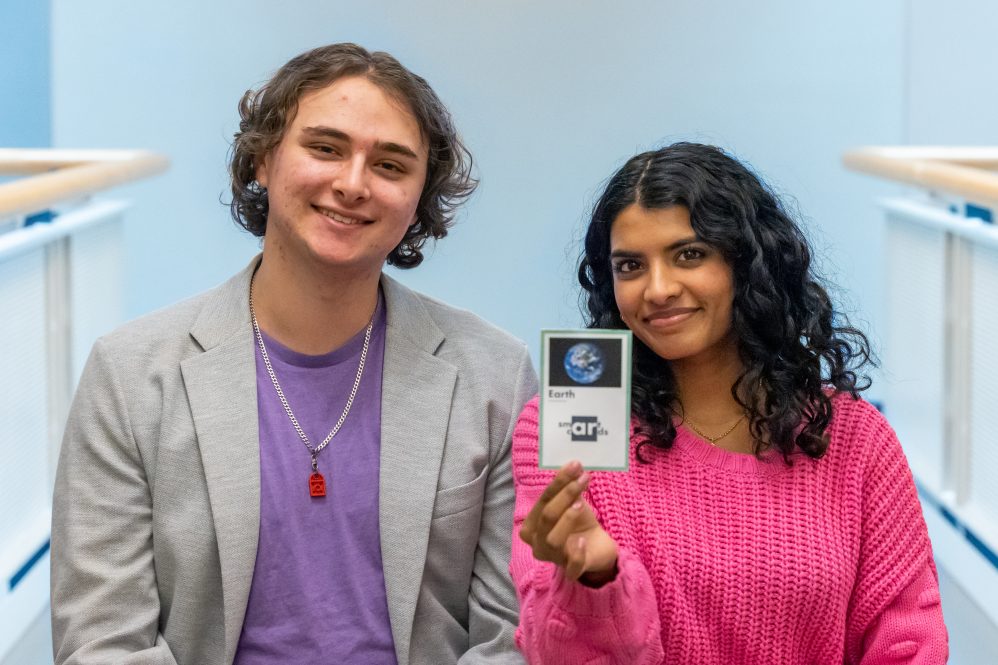In traditional classrooms, young students might spend the day sitting still for extended periods while listening to teachers talk, sometimes too fast. It’s not a system that works for all, often leaving behind those who learn differently, such as neurodivergent students with conditions like dyslexia, attention-deficit/hyperactivity disorder (ADHD), or autism.
Justin Nappi ’24 (CLAS) and Sudiksha Mallick ’23 (CLAS) hope to change that.
Nappi and Mallick are cofounders of SmartCards AR, LLC, a learning platform that combines augmented reality (AR) technology with physical flashcards to provide an interactive educational experience for students in grades 2-5, particularly those who are neurodivergent. Mallick, a double major in political science and human rights, specializes as a spokesperson for the start-up, while Nappi works on the development and technology side.
Nappi’s individualized adaptive programming and design major combines areas that are central to SmartCards, including machine learning, educational psychology, and game design. His own time in the classroom influenced the idea for his and Mallick’s product.
“It was just something I had in the back of my head from my experience with video games growing up and how they helped me grow as a person, and also my experience with the education system as well,” Nappi explains. “I had undiagnosed ADHD growing up. Luckily, I did well in school [and] had the support I needed, but I would still always hear these teachers [saying] ‘Pay attention; stop distracting your classmates,’ and constantly [being] on me about my behavior.”
Merging Learning and Fun in Augmented Reality
SmartCards can function as typical physical flashcards with pictures and pieces of information. However, the cards are designed to interact with technology for hands-on learning.
With a tablet, students can log in to the SmartCards web app. They can then take a SmartCard and place it on a table in front of the device’s camera, which will sense and scan special markers on the flashcard’s picture using image-tracking technology. The device will then display the associated scene in augmented reality for students to interact with using hand gestures and buttons.
“We want to give students the ability to take these 3D objects that appear in the augmented reality space, and manipulate them,” says Nappi. “So if you’re learning about the earth, we want [you] to be able to take the layers of the earth apart and look at it that way.”
SmartCards also interact with each other. For example, students can take the earth and moon cards, place them next to each other, scan with the camera, and watch the moon orbit the earth. They’ll also get related facts about the moon and the earth.
Nappi and Mallick are starting with a solar system-themed deck of flashcards, which they’ve tested themselves and are continuing to develop with the help of an agency. They hope to get the cards in children’s hands around April for them to test and provide crucial user feedback.
Getting SmARter on the Issue
SmartCards began to take flight when Nappi met Mallick in Spring 2021 in a course called “The Entrepreneurial Journey” led by David Noble, director of the Peter J. Werth Institute for Entrepreneurship & Innovation, and Tara Watrous, the Werth Institute’s head of entrepreneurial transformation. During the social distancing brought on by the COVID-19 pandemic, Mallick says Noble and Watrous encouraged the students to develop relationships with each other, and tasked them “to come up with a solution to a societal problem.”
“[Justin and I] immediately connected over our goal of changing the way we think about education, and the way we view education, and the ways in which education is limited toward only certain types of students,” Mallick says.

Researching extensively, Nappi and Mallick found that 1 in 4 learners today are neurodivergent, and have different learning styles that often aren’t conducive to the traditional classroom setting. Mallick explains these students are often removed from class as a result, creating an educational gap between them and their peers.
Mallick also knew from her high school experiences of working with students with disabilities that they’re no less smart than their peers, yet may be perceived as such when they’re removed from class, creating harmful biases. Nappi, who participated in unified sports with people with autism and Down syndrome, says the SmartCards project is intended to address these problems.
“[Neurodivergent people are] some of the nicest people you’ll ever meet, but at a lot of schools, you don’t have the opportunity to meet them because they’re in different classrooms, and it’s all for their education,” Nappi says. “But they’re really missing out on this social piece. So I always thought there had to be a way to incorporate some sort of video games/having fun with education to give them a leg up so that they don’t have to be removed from the classroom.”
While the cards are targeted to neurodivergent students, Mallick and Nappi’s goal is to find an intersection between technology, learning, and entertainment for all students in school and at home.
“Especially when you’re a younger student from grades 2-5, learning doesn’t have to be this thing that’s so stressful and competitive, and you just sit and learn,” Mallick says. “It can be something that’s fun. It can be something that you enjoy doing.”
Meeting Challenges and Moving Forward
Running a business hasn’t been easy for Nappi and Mallick, as they work with novel AR technology, handle public relations, meet with investors, and do much more— all while being full-time undergraduate students.
However, the student-entrepreneurs credit much of their success to those at the Werth Institute like Noble and Watrous, who continue to advise them and provide opportunities like their recent participation in the Big East Start-Up Challenge. Mallick and Nappi also recognize UConn’s uniquely supportive entrepreneurial environment, as they’ve befriended and mentored many other students with their own start-ups and businesses.
“I feel like a lot of times when I talk to my peers in other schools who have done entrepreneurship, it’s this cut-throat, competitive environment where you’re constantly trying to climb the ladder,” Mallick says. “You’re constantly trying to get ahead of other people. You’re trying to pull them down to get up. Whereas the difference that I see at UConn – like what David [Noble] has really created – is that we are all trying to pull each other up to bring us all up together.”
Noble, meanwhile, notices how much Mallick and Nappi have themselves grown since they started SmartCards in his class two years ago.
“Justin and Sudzy met in my class as freshmen, and they never could have imagined such a shared purpose around education and technology,” Noble writes via email. “I have had the pleasure of working with them ever since as they have grown from children in the pandemic to young adults pursuing the development of SmartCards in earnest. Their journey will build a shared experience from college that they will always remember.”
While Mallick and Nappi know that much work lies ahead as they continue to build SmartCards, they’re proud of how much they’ve grown as entrepreneurs after beginning with little to no experience. As Nappi shares, they’re also dedicated to the goal of “including everyone in the learning process and not discriminating based on how you learn.”
“Of all those moments that we could have chosen to stop, we continued to keep going,” Mallick says. “We thought that this was something that we really wanted to see. I think it goes to show how much we care about the issue as well.”



